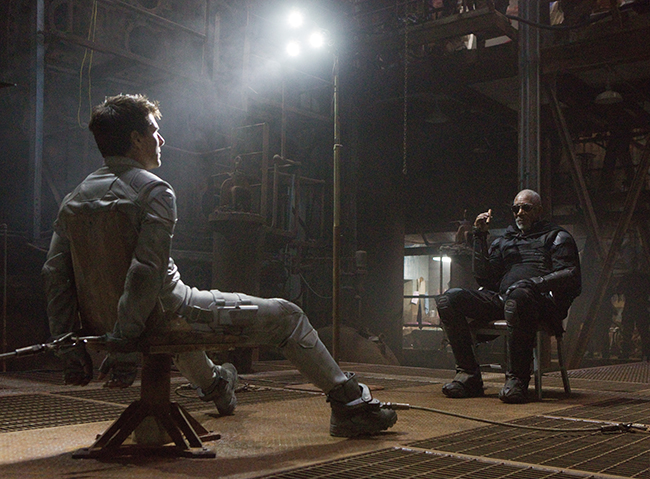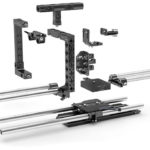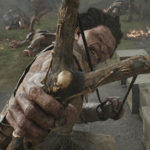
Earth Bound: The Oblivion Movie And How To Avoid Blue Screen
Posted on Apr 16, 2013 by Alex Fice
The front projection of a 500ft screen gave the DoP and actors a real environment to control and act in.
Tom Cruise seems to be experiencing some kind of resurgence as his latest movies have been wildly popular. His absolute latest, Oblivion, has a number of firsts attached to it. This is the first movie released that has been shot with Sony’s flagship movie camera the F65, a 4K monster of a digital camera. The movie also features some ingenious staging techniques by DP Claudio Miranda, (fresh from winning an Oscar for Life Of Pi), and Director Joseph Kosinski, director of Tron, a film shot by Miranda. To avoid using too much blue screen Miranda and Kosinski designed a projection system for what is called the ‘Sky Tower’ sequences where many of the scenes are set. The staging required the use of a 500 foot screen front projected by 21 projectors with a large choice of sky scenes as moving plates. The Sky Tower is a living quarter perched 3,000 feet up in the sky.
Claudio looked forward to working with the new Sony camera and describes the Sky Tower staging: “We used the f65 for the movie, I have worked with the Sony system before, the F35 on Tron, so it’s all kind of similar as far as the look is concerned. There was an intention of the movie being a 4k release but it ended up being a 2k release just like 95% of all movies.
“We used 21 projectors on the 500 feet wide screens for the Sky Tower scenes. It’s the whole background and all in-camera which is something that is very unusual for this type of movie. Most people think that outside the Sky Tower is blue screen but this is all in-camera projection. So 21 projectors to go around 500 feet, to light it, to give me enough stop, to use all the background.
“Joe Losinski and I had a discussion to try and do less blue screen on this movie. We had both worked on Tron. On that we loved to put as much in-camera as we could or as much as the budget would allow us to do. We wondered if we could make a whole environment and maybe we should shoot some tests and we’ll do some projection and see if we can do this all in-camera. There was some talk about maybe using some gel or grads but that just looked terrible. But then I threw up some clouds on a projector and it just looked amazing and totally real. I had been working on it for a couple of weeks and planning it and working it out and it’s pretty unique.
“If we had done it blue screen then all your art department choices like textures would have to change. If it originally was going to be gloss it would have to be semi gloss, no chrome is allowed because it just ends up being blue. You could put chrome in but the effects would have to go on top of it. But now we’ve got real chrome we can put the glass in and now we have a real environment. I can use smoke if I want to, I can do anything! I can have the sun where I want to. Sometimes I would move a nice looking cloud to go behind them and would nudge it over a little and maybe loop a certain section that looked great right behind the actors. So it’s all in-camera, you’re making choices and lighting choices because you have the real thing.
“The actors really loved because they’re in the environment, Tom (Cruise) loved it. Of course we had to shoot the backgrounds, so I sent a crew to Hawaii to a top of a mountain and they shot 15k with a three camera rig to get moving plates for all the backgrounds. So 15k was distributed amongst 21 projectors so the resolution per projector was pretty low, just a little under 1k per projector, but being clouds and non-resolute it kind of helped it.
“That way was very refreshing for me after shooting Life Of Pi and actually easier for me. For Pi to go out there in the ocean and shoot to a reference the whole time is hard, like ‘Its 12 noon, its hot, the clouds are a little bit bleak’, and then I’d light to that. So I feel it was like that and then VFX would put their balls in, then they extend it in to infinity.
“There’s none of that going on in here. The skin reflections are really reflecting the background. If they’re slightly sweaty or wet that would be a real problem in the shooting of Life Of Pi, that’s kind of why I chose blue screen in Pi so you can get a little of the reflection in the skin. Green would have compromised Pi as far as the look was concerned. It was nice in Oblivion not having that debate or argument or indeed workaround. Pi was a lot of work and it’s not totally perfect. I had three months of playing back and forth on that movie and I still wish I had more time to finish it.”
Control Of The Image
The avoidance of blue screen work for Oblivion and the use of a performance space is indicative of Miranda’s search for control of his image throughout the movie. He doesn’t use LUTs and doesn’t believe in any ‘lighting looks’ on set. “I’m usually with Directors that kind of get it. We could go warmer or colder with slight nuances. I’ll have one LUT that I’ll make for everything and basically it’s just a little bit of contrast. For me it puts the sensor in the sweet spot, has a little bit of contrast and a little bit of colour and I know I have the over and under of that in the digital negative. Then I’ll go in to the lab and after work and I’ll spend some time just making sure the dailies are correct. That’s much better than painting on-set.
“DPs can have control if they choose to. Some DPs choose not to and when they finish shooting maybe they’ll visit the DI a little bit. I think that’s unfortunate as the modern way DPs need to react is to be a little more ‘embrassive’ of the image and compositions and not just let ‘pre-vis’ run completely wild. You are the director of photography, I feel I need to be involved, it’s my job.”
Claudio doesn’t want you thinking that there isn’t any blue screen work involved, it is a science fiction movie after all but he is controlling the lighting as the bubble ship rig flies. “When Tom’s flying around in the Bubble Ship, that is blue screen. There I have lighting cues from the pre-vis, he’ll pop out of the rain clouds and the sun will hit him with a light and then he’ll go below in to the trenches of the canyon so then there are side lights and just top lights and then sun light again. Then he goes behind a waterfall with less of a top flight and then he comes out and fires his gun with intermittent lighting. So this scripted lighting sequence is put together to make him feel he’s in this environment. In the DI you take things a bit further once you seen the actual effect in place. The lighting board has all these different cues on them from the pre-vis. Clouds are ‘everywhere lighting’ with a bit of pulsing to reflect the different densities coming from different places. You can tune it up in the DI but you can’t change lighting direction.
 Claudio used the light on Tom Cruise as a bounce card to reflect in Morgan Freeman’s glasses.
Claudio used the light on Tom Cruise as a bounce card to reflect in Morgan Freeman’s glasses.
“We also built this beautiful set which is the library when he’s going down the shaft of light and that’s all in-camera as well. They built this huge interior library set and there’s a big shaft of light that comes down from what was New York. As he goes deeper in to the room the light runs out and at the bottom Tom’s flash light is the light source lighting the scene. There are only a couple of little white cards bouncing around. I’m thinking ‘I can’t believe I’m lighting this whole thing with a flashlight!’ There was also the Morgan Freeman scene with Tom when he lights the match and it lights his face and there’s a reflection of Tom Cruise in there and for some reason it looks a little fake! It’s actually real. I brought Tom a little closer to Morgan and I lit him brighter and I told him ‘Tom you’re the most expensive bounce card I ever used!’ Morgan was wearing these highly reflective glasses so I couldn’t use a card on Tom to bring him up a little. We were on the hairy edge of the darkness there but it looks cool not seeing Morgan initially. He originally was going to be more of a silhouette with more people and light in the background but John and I realised we were just chickening out! I think when he lights the match it feels really strong.
“There was one scene in the movie where I was pushing the exposure a lot. Normally I’ve done candle scenes where people are kind of close to the one candle and then let it light the scene between them. There is a shot with Tom and Andrea (Riseborough) who are having an intimate dinner sequence together and talking back and forth. There is one candle in the middle of them and I’m hoping it’ll light them, it’s very kind of under. But it looks beautiful. This is all in the projection world too with a full moon night scape reflecting on their faces.”
Oblivion was shot with the Sony F65 but also used RED Epics: “It is a physically big camera and there were times when we needed super speedy steadicam. The F65 was just a little large for that, it’s has a slightly unfortunate form factor.”







